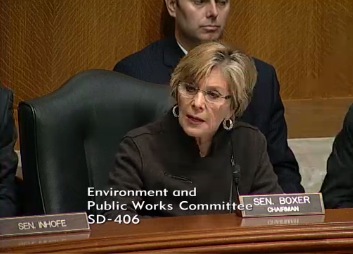
EPW Committee approves transportation bill by voice vote, moves it out of committee
 The Senate Environment and Public Works Committee approved its two-year highway reauthorization bill this morning and moved it out of committee by a bipartisan, unanimous 18-0 vote. (Read our statement here.)
The Senate Environment and Public Works Committee approved its two-year highway reauthorization bill this morning and moved it out of committee by a bipartisan, unanimous 18-0 vote. (Read our statement here.)
The committee markup was short, as compared to a typical markup of such a large bill, but that was a testament to the work done behind the scenes by Senators Boxer, Inhofe, Baucus and Vitter to get consensus among the four of them on the major policy points.
At the markup, a single package of amendments, known as a manager’s amendment, agreed to ahead of time by the four key Senators, was approved by a unanimous voice vote. No other amendments were voted on, though many others were filed.
After that amendment package was approved, Senators took turns talking about other amendments that they had drafted but weren’t formally proposing, in order to preserve the bipartisan vote and also because the four committee leaders made it clear they would oppose any other amendments, effectively ensuring no amendments would pass — a process known as “offer and withdraw.”
Senators talk about their amendment, offer it, and then note that they’re not calling for a vote and withdraw the amendment. The idea behind this is to indicate the Senator’s desire to continue to push an issue and work with the Committee to find ways to incorporate concepts into the final bill as it moves to the floor.
There were a few smart, notable amendments offered in that way, and a handful of others that were not offered. Sen. Gillibrand talked at length about a program that would help train low-income workers, but we’ll be talking more about those amendments in the days and weeks to come as the bill moves forward.
Here’s a summary list of the amendments that were approved in the manager’s package. Some other small changes to the bill were made in an amendment written and approved by the four committee leaders, but that text is not yet available. Additional explanatory notes from T4 America are in italics.
(Amendment data derived in part from Transportation Weekly and Jeff Davis.)
| Senator, Amendment # | Description |
| Barasso #2 as modified | National Freight Program flexibility for rural roads |
| Barrasso #4 as modified | Limits the number of performance measures, directing the Secretary to study and establish only the “most effective” performance measures. |
| Boozman #1 as modified | CMAQ accountability study. Co-written with Sen. Carper. |
| Cardin #4 as modified | FHWA to FTA flex used to enhance level of service. This amendment will make it easier to use funds from the new National Highway Performance Program (generally dollars for interstate and national highway system funds) on transit projects. This amendment lowered some of the hurdles that made it hard to flex that money, as MAP-21 was written. |
| Carper #3 as modified | Clarify off-road diesel PM2.5 rules and funding |
| Crapo #2 as modified | Directs states to “consult” rather than “cooperate/coordinate” on transportation planning with rural areas and small urban areas under 200,000. |
| Crapo #3 as modified | State DOTs that have a current statewide long-range transportation plan will be exempt from having to do performance planning for four years. States that developed policy plans can keep using those plans for 4 years, without having to write a new long-range plan. Does not cover MPO planning, only states. |
| Gillibrand #1 as modified | Freight rail improvement within 5 miles of Mexico, Canada borders |
| Johanns #2 | State comment process on DOT standards for National Highway Performance Program |
| Johanns #3 | Require DOT to give tech support to states for data modeling |
| Johanns #5 | Narrow scope of fines in sec. 2210 of bill |
| Merkley #3 as modified | Require MPO alternate scenarios to be fiscally constrained |
| Sanders #1 as modified | Increase ER fed share to 100 percent in certain circumstances |
| Sanders #3 | DOT report on potential electric car charging network |
| Udall #1 as modified | Define border roads as within 10 miles of border |
| Udall #2 | Use of crash rate as a safety analysis/planning factor. This provision ensures that rural roads with high crash rates receive equal attention under the Highway Safety Improvement Program. Rural roads may have few crashes relative to busier roads, but far less traffic, resulting in a higher rate. Using crash rate as a planning factor should help dangerous rural roads see increased safety funding. |
| Udall #3 | Eligibility for alternate roads along a corridor when its more cost effective than improving primary route. |



